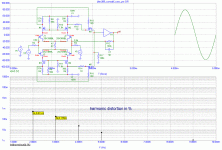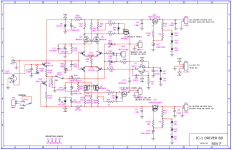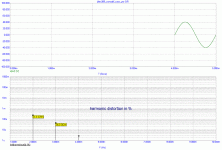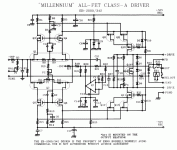john curl said:Very good Edmond, you get a gold star. You are only off by a factor of 2 or so, due to the amplitude loss across the fet follower, itself. Fire up the simulators gentlemen, and get me an exact value. Cap value changes are OK, as well
BTW John, I was not only 'a factor of 2 or so' wrong, rather a factor of 4.
BUT.... it has nothing to do with the fet followers.

It's R39=33k (of the servo) that spoils the balance. In this case the correct value of the input series resistor is ~15k5.
Without that evil R39 and using two identical input buffers, the input series resistor should have the same value as R40, 3k83 (3k43 was a typo).
jacco vermeulen said:Don't get your hopes "up" too high, it could be a temporary thing, Mr Ovidiu.
[OT]
Resistance is futile. You will be assimilated.
[/OT]
Edmond Stuart said:
BTW, has JC ever shown a schematic? No! One more reason to not drop a schematic.
Short memory. The JC-1 was up yesterday. John didn't actually post it (he doesn't have a way of hosting it), but he sent it to me to post. This wasn't the first one I put up for him, and there's another one coming a little bit later.
To me it is low enough. Nice harmonics envelope, too.
Low or high is a matter of reference.
What happens if you load it a bit harder?
Do your models of the MOSFETs simulate distortion correctly?
Sigurd
Low or high is a matter of reference.
What happens if you load it a bit harder?
Do your models of the MOSFETs simulate distortion correctly?
Sigurd
PMA said:Back to the trees; is this low, or high distortion?
PMA said:Back to the trees; is this low, or high distortion?
1. Since when is CMRR not a 'tree'? Also, it's not up to you who determines whether CMRR is an unimportant issue.
2. This distortion sim of the IPS is meaningless without simulating the (non-linear?) input impedance of the OPS as well.
3. Almost every mid-fi amp scores quite well at 1kHz. So, I'm not really impressed. Besides, you should also look at worst case conditions: above 10kHz or so, where the real troubles start.
PMA said:This REV F is missing +IN/-IN input resistors (R + R//C), that carefully balance for impedance mismatch.
.......
So what are the exact values of these missing components? Or even better, show us a schematic, so I can verify if the IPS is indeed carefully balanced, instead of wasting my time on an incomplete schematic.
SY said:Short memory. The JC-1 was up yesterday. John didn't actually post it (he doesn't have a way of hosting it), but he sent it to me to post. This wasn't the first one I put up for him, and there's another one coming a little bit later.
Stuart, I didn't know that. Instead, I thought that someone has reverse engineered the JC1, because the schematic came (misleadingly) from another website (yours in fact). Besides, why didn't JC drop the schematic by himself. If I can do it (see below) he can do it too.
Attachments
john curl said:Actually, Edmond, I scaled the input impedance to 50K, instead of 100K. Now, what value do you get?
Suppose that R82=43k, I get 6k73 (then the input impedance is 49k73, almost 50k).
Edmond Stuart said:
3. Almost every mid-fi amp scores quite well at 1kHz. So, I'm not really impressed. Besides, you should also look at worst case conditions: above 10kHz or so, where the real troubles start.
No, they do not do at 80Vp, and they have high order harmonics.
Do your models of the MOSFETs simulate distortion correctly?
[/B]
This is the weakest point, also for slew rate analyze. Just enough for rough estimation. I like these circuits, they have nice behaviour with low components count, elegant and clever.
Not a boost of current mirrors and CCS. Active CCS and mirrors have their dynamic behaviour, when I designed my preamp and compared, the resistor biased, highly degenerated version was the best and that one was actually produced.
PMA said:No, they do not do at 80Vp, and they have high order harmonics.
Okay, not 80V, but you and I were talking about distortion in the first place. In the mean time, I've simmed the front-end of Self's blameless amp. As you know a very simple amp and by some considered as mid-fi.
At Vo = 41Vpk (not Vpp) and 1kHz, I get 0.5ppm (when doing it your way). Almost all 3rd harmonic. As you see, 'slightly less' than the JC1.
If I simmed it the correct way, i.e. also connect the OPS to the VAS, then I get 0.8ppm, mainly 2nd and 3rd harmonics. The 7th harm. is 8ppb.
Edmond Stuart said:
Besides, why didn't JC drop the schematic by himself. If I can do it (see below) he can do it too.
There's probably a lot of things you can do that I can't, either.
Anyway, here's the latest from John.
www.syclotron.com/old_2200_.jpeg
I like these circuits, too. They are elegant in their simplicity.
Borbely uses this design, too. For both line and power amps.
See attachment for his Millenium power amp.
MKV-models of MOSFETs give more accurate distortion simulations, AFAIK. Not many around, though.
andy_c or syn8 made some for output MOSETEs.
Sigurd
Borbely uses this design, too. For both line and power amps.
See attachment for his Millenium power amp.
MKV-models of MOSFETs give more accurate distortion simulations, AFAIK. Not many around, though.
andy_c or syn8 made some for output MOSETEs.
Sigurd
PMA said:
This is the weakest point, also for slew rate analyze. Just enough for rough estimation. I like these circuits, they have nice behaviour with low components count, elegant and clever.
Not a boost of current mirrors and CCS. Active CCS and mirrors have their dynamic behaviour, when I designed my preamp and compared, the resistor biased, highly degenerated version was the best and that one was actually produced.
Attachments
Sigurd Ruschkow said:
andy_c or syn8 made some for output MOSETEs.
andy - not me.
PMA said:Edmond, why do you mislead with Vp-p? I had 80Vp, i.e. 160Vp-p.
41Vpeak is here:
P.S.: this is about nothing. These parameters, in such level, are unimportant and inaudible.
1. Me, misleading? Quite the opposite I would think. I wrote Vpk, meaning the peak amplitude as you probably know and to avoid any confusion with the peak to peak value, I added 'not Vpp'. Apparently for people like you, not clear enough. I'm deeply sorry.
2. It's becoming an annoying habit of you by suddenly declaring it as 'unimportant' whenever I drop comments you dislike. Moreover, if it's really that unimportant, why you have simulated the distortion anyhow?
3. I insist that I'm not impressed by your figures, as even the blameless front end (in terms of distortion) performs better.
PMA said:
P.S.: this is about nothing. These parameters, in such level, are unimportant and inaudible.
I agree. Using unbleached cotton insulated, solid silver wiring is way more important (and audible).
syn08 said:I agree. Using unbleached cotton insulated, solid silver wiring is way more important (and audible).



- Status
- Not open for further replies.
- Home
- Amplifiers
- Solid State
- John Curl's Blowtorch preamplifier



